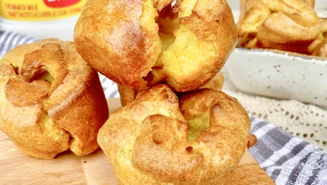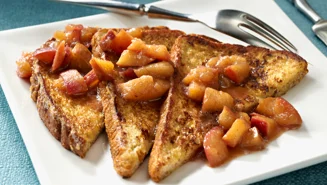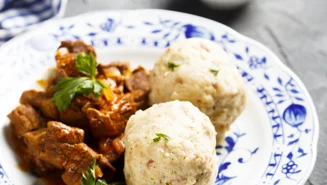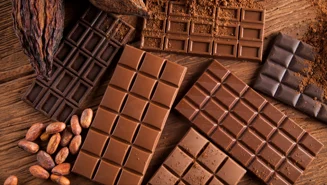
One of the best things about cheese is that you have a delightfully big assortment to choose from. This applies to regular as well as lactose-free cheeses – the latter offering just as good a texture and flavour as the former. Read more about lactose-free cheeses.
If you are looking for cheeses with lower lactose levels, our cheese chart below is just what you need. So, keep reading and prepare for your next delicious cheese platter with cheeses with lower levels of lactose.
Lactose in cheese chart
Our cheese lactose chart is here to guide you through the world of cheese with lower lactose levels. And remember, they are just as tasty as cheeses that contain more lactose!
Keep in mind that the lactose content can vary depending on different factors such as ageing and the cheesemaking process unique for each brand. So, you should always check the product label to be sure about the levels.
Our cheese chart shows different delicious popular cheeses with lower lactose levels like Swiss cheese, renowned for its characteristic holes and nutty flavour, as well as brie and camembert with their exquisitely creamy texture.
You can also find aged or mature cheddar, gouda, with its rich and distinct taste, and parmesan, which we all know and love from authentic Italian cuisine, on the list. The same goes for semi-hard provolone, also from Italy, classic crumbly Greek feta, and softer, airy mozzarella.
| Cheese | Lactose content (per 100 grams) |
|---|---|
| Swiss cheese | 0-1 grams |
| Brie | 0-1 grams |
| Camembert | 0-1 grams |
| Gouda | 0-2 grams |
| Parmesan | 0-3 grams |
| Feta | 1-2 grams |
| Provolone | 1-3 grams |
| Fresh Mozzarella | 1-3 grams |
| Cheddar | 1-3 grams |
Understanding lactose levels in cheese
Our cheese chart is a handy guide, although not exhaustive. As mentioned above, the levels can change depending on different factors such as the specific production method.
To begin, lactose is milk sugar, a naturally occurring sugar in milk. The lactose level in cheese is influenced by factors such as the type of milk, the cheesemaking process, and how long it is aged. So, for example, aged cheeses have had time to mature, meaning they are lower in lactose than fresh cheese types because the milk sugar in aged cheeses has had more time to be broken down by bacterial cultures.
Although there is no set rule about lactose levels, many tend to consider cheese with a lactose level under 2-3 % as containing comparatively little lactose. Cheese most often falls within the range of 0 % to 3-4 %, so under 2-3 % is, in comparison, quite a low amount.

Are some cheeses naturally low in lactose?
Some cheeses contain very low, almost untraceable, levels of lactose because of their production process and ageing period.
What constitutes ‘lactose-free’ depends on local rules and regulations, so be sure to check the rules for your country.
Different types of cheese with lower lactose contents
Are you ready to explore some different types of cheese with lower lactose levels? Then keep reading below about some of these favourite cheeses!
Cheddar
Cheddar, a semi-hard cheese, is known for its nutty flavour and smooth texture. The flavour can range from mild to sharp, depending on the length of ageing. Mild cheddars are typically aged for a few months, while sharp ones can be aged for a year or more, which also has a saying in how much lactose they contain.
Use it in sandwiches and burgers, mac and cheese, casseroles, and much more. The smooth texture and sharp flavour make it a popular choice for melting, grating, and snacking alike.
If you want it completely without lactose, look for a verified lactose-free cheddar. Also, check out everything you need to know about lactose-free cheddar here.
Brie and camembert
Creamy brie and camembert are both semi-soft cheeses with a similar – somewhat low – amount of lactose. The lower lactose content in them results mainly from the cheese-making process where fermentation by lactic acid bacteria, ageing, and the draining of whey all contribute to reduced lactose levels.
They are both originally from France and share some characteristics, though they have slight differences in their taste and texture.
Brie has a soft, creamy texture and a mild, buttery flavour. It is often served as a dessert cheese and pairs well with fruit, nuts, and crackers. It can also be used in savoury dishes like quiches and sandwiches. Read more about lactose-free brie.
Camembert too has a creamy and soft texture. It has a slightly tangy flavour and is often served as an appetiser and pairs well with bread, fruit, and wine. It can be used in a variety of dishes, including omelettes, soups, and sauces.
Swiss cheese
Swiss cheese is a popular semi-hard cheese typically made from cow's milk. Especially because of how long it has aged, it contains little lactose, and did you know that it is known and recognised for its distinctive holes? These are caused by carbon dioxide bubbles that form during the cheesemaking process.
It has a mild, nutty flavour and a smooth texture that makes it a great choice for melting in dishes like sandwiches, omelettes, and quiches, but it is also delicious on its own as a snack or paired with crackers and fruit.
Feta
Feta is a crumbly, white cheese traditionally made from sheep's milk or a blend of sheep's and goat's milk. It is made in specific areas in Greece and is known for its tangy, salty flavour and crumbly texture.
White cheese and salad cheese, often made from cow’s milk and produced outside of Greece, have a similar taste and texture to feta. However, these often have a higher lactose content than feta, partly due to differences in the cheesemaking and brining process that play a big role in reducing feta’s lactose content.
Enjoy feta on its own as a snack or use it in dishes from Greek and Mediterranean cuisine. For example, as an ingredient in salads, sandwiches, and pastries, or to flavour sauces and dips.
Read our article about lactose-free feta to learn more about this delicious, authentic Greek cheese.
Gouda
Gouda is a semi-hard cheese usually made from cow's milk, although it can also be made from goat's milk or sheep's milk as well. It is originally Dutch and has a mild, slightly sweet flavour and a creamy, smooth texture that makes it a popular choice for snacking and sandwiches.
Gouda is typically aged for varying lengths of time, ranging from a few weeks to several years. Younger goudas tend to be softer and creamier with a milder flavour, while aged goudas are harder and crumblier with a sharper, nuttier flavour. The harder, more aged goudas have a lower lactose content, but even semi-hard ones have a low enough level to land them a spot on our cheese lactose chart.
Parmesan
Parmesan is a hard, dry cheese typically made from cow's milk. It originates in Italy and is known for its distinctive nutty, salty flavour, and granular, flaky texture. It is usually aged for at least 12 months but can be aged for 36 months or more, depending on the desired flavour and texture. This affects the levels of lactose but generally keeps it on the lower end of the scale.
It is a versatile cheese, often grated and sprinkled over pasta dishes, soups, and salads, and is also delicious as a flavourful ingredient in sauces and marinades. It’s hard, dry texture makes it easy to grate, and its strong, nutty flavour adds depth and complexity to many dishes. Read more about lactose-free parmesan.

Making lactose-free cheese
Some cheeses are actively made to contain no lactose. At Arla, we use a two-step process to remove and break down lactose when we make the cheese.
First, milk is run through an ultrafiltration plant to make a lactose-free milk drink to use for the cheese concentrate.
The enzyme lactase is added to the concentrate to break down lactose into simpler sugars during the maturation where bacterial cultures also consume lactose and convert it into lactic acid.
Lactose-free cheeses can be soft or hard, fresh or aged, and made from any type of milk, allowing you to choose between many different delicious cheeses.









































